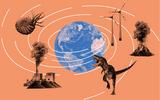MEK – J3 T2 1 – Plants – heroes with superpowers
Plants are a vital resource. They provide food for numerous other organisms. But they also help to combat rising temperatures by removing the greenhouse gas carbon dioxide CO2 from the air.
With the aid of chlorophyll, their green pigment, plants work wonders: in the chemical process of photosynthesis, sunlight, water and CO2 are transformed into oxygen and glucose. These products are then turned into building blocks for leaves, stalks and trunks.
This means that long-lived plant material, such as wood, is a valuable carbon sink. The CO2 stored in plants is only released again when they rot or are burned.
MEK – J3 T2 2 – Cooling oases in cities
Global warming is causing increasingly frequent heatwaves, with soaring temperatures in cities. In these “heat islands”, people suffer from a variety of health problems, and death rates rise.
Here, too, plants can be lifesavers, helping to keep cities liveable in the future. They create cooling oases in concrete deserts, providing shade, releasing water vapour and acting as natural air conditioners. Plants also filter pollutants out of the air.
For this reason, urban planners are increasingly developing “sponge cities” – with more water, more vegetation, and more green spaces for people and nature.
